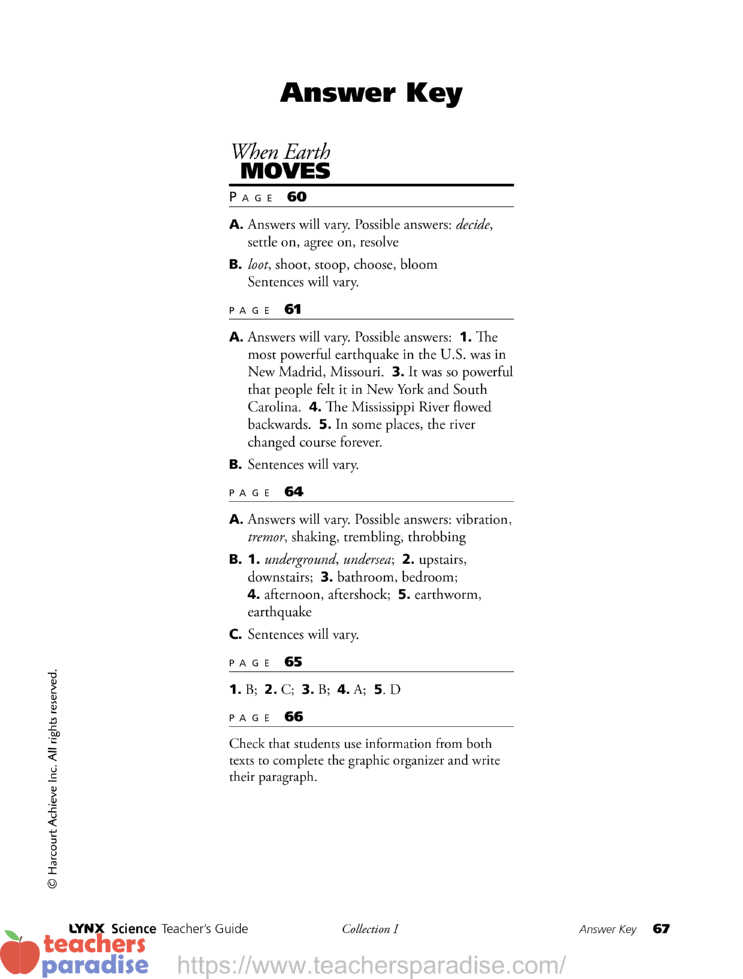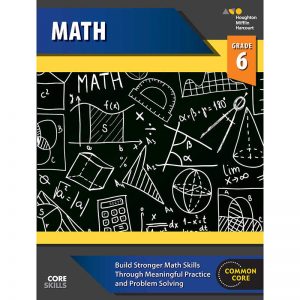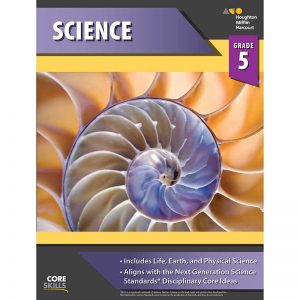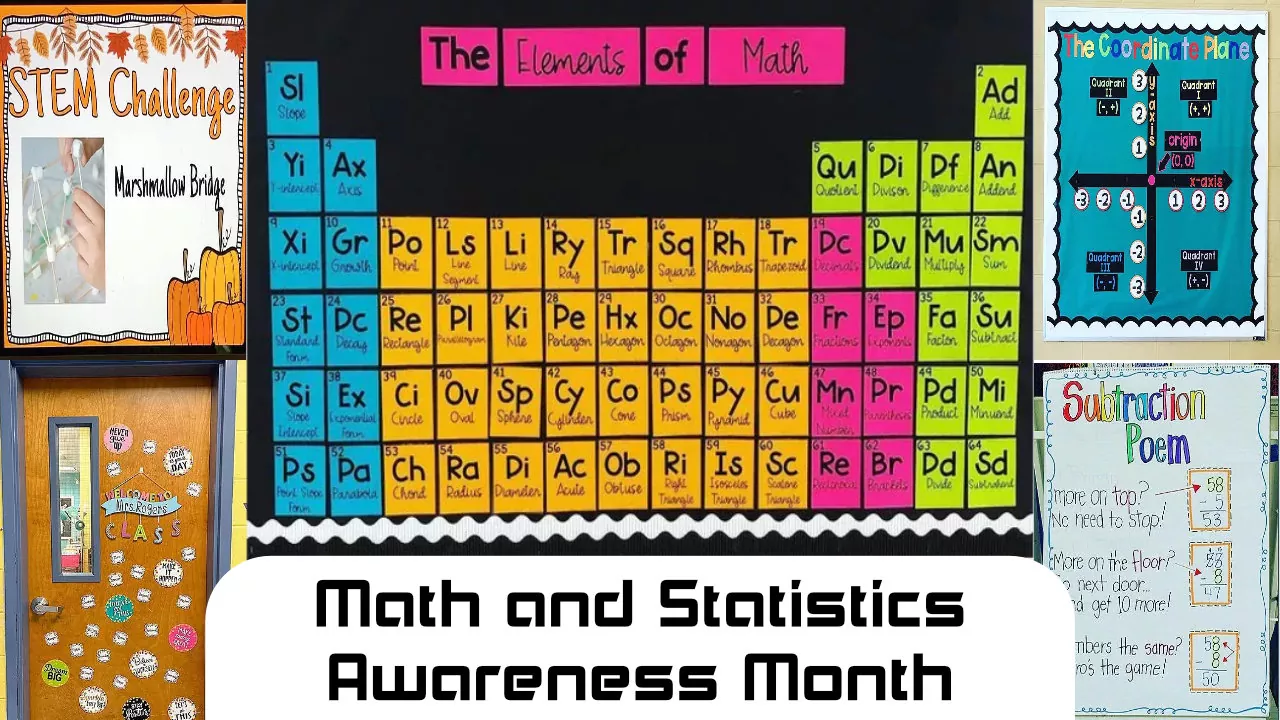When Earth Moves – Science Teacher’s Guide
GRAPHIC NOVEL
Summary
A group of teens explores a cave near a long-dormant volcano and discusses geological formations and processes. When the volcano erupts, they learn even more in their exciting flight to safety.
NONFICTION BOOK
Summary
Earth’s surface is often disrupted by shifts in its tectonic plates, causing volcanoes, earthquakes, and sometimes tsunamis. Read dramatic eyewitness accounts of these disasters, and explore their causes and effects.
Links to Science
How Science Works
Scientific explanations, including logical arguments, models, and theories, are based on evidence from research.
Earth Science
- Atmospheric changes, geologic shifts, glacial movement, ocean temperatures, and volcanic eruptions can affect Earth’s climate. 2. Landforms are created through a combination of positive forces (volcanic eruptions) and negative forces (weathering and erosion).
WORKSHEET & Sample PDF Activity
Sample PDF Activity
Physical Science
Vibrations (from sound, light, earthquakes, etc.) move in waves at different speeds and have different wavelengths.
Life Science
Animals process, react to, and store information from the environment.
Links to Reading/Language Arts
Comprehension Compare and Contrast
Comprehension Main Idea and Details
Vocabulary Synonyms and Antonyms
Phonics/Word Study Dipthongs/Compound Words
Text Feature Cross-Sectional Diagrams
Literary Analysis Character Traits
Nonfiction Genre Interview
Vocabulary Links
determine (verb) to decide something; to make up one’s mind
factor (noun) something that helps produce a result
pressure (noun) the force produced by one thing pushing against another
transform (verb) to change something’s shape or appearance
vent (noun) the opening in a volcano through which lava and ash escape
compression (noun) the act of squeezing together
vibration (noun) a rapid back and forth movement
Links to Textbooks
Earth Science Units
• Earth’s surface
• Inside Earth
• Earth’s waters
Physical Science Unit
• Sound and light
Life Science Units
• Ecology
• Animals
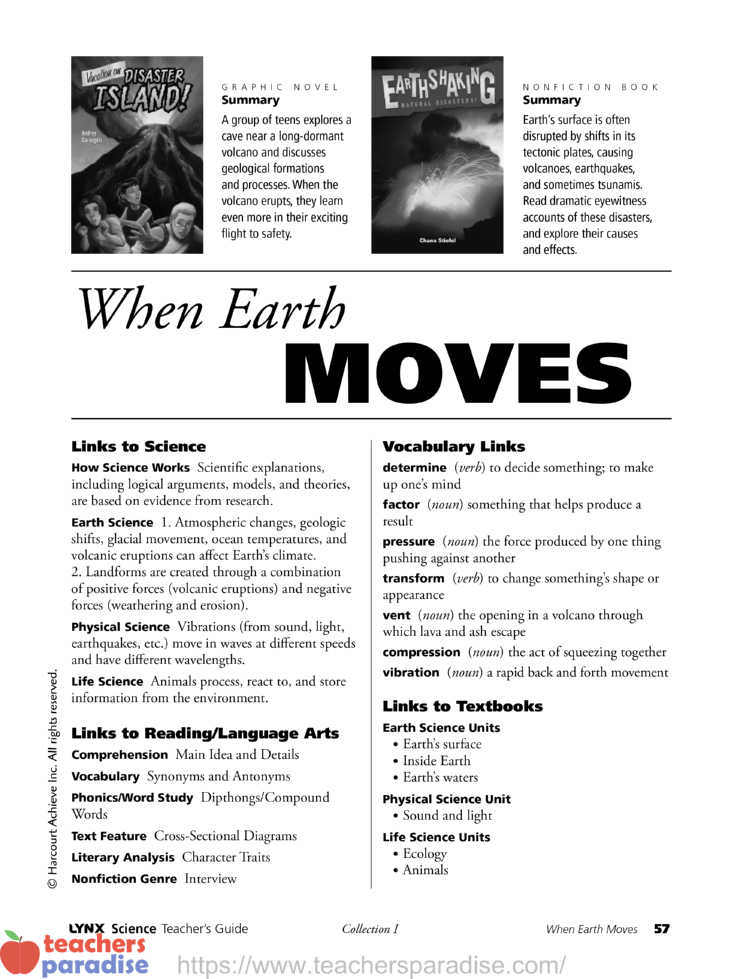
When Earth Moves GRAPHIC NOVEL
STEP 1 Introduce Theme
Make a Personal Connection
Ask Have you ever seen an earthquake on TV? Have you ever been in one yourself? What did it look or feel like? What damage did it do? Invite students to talk about what they know.
Build Theme Background
Explain that natural disasters are more common in certain parts of the world. They often occur in areas where the earth’s plates—huge, continent-sized slabs of Earth’s crust—move toward, away from, or past each other. Review the Big Ideas on page 2 with students.
Preview Text
Distribute copies of Vacation on Disaster Island!, and discuss the book cover. Ask What is happening on the cover? What kinds of things do you think will happen in this story?
• Preview what the character says on pages 2 and 3. Ask What do you think these teenagers are doing near a volcano? Why?
• Have students preview pages 4–11, and ask them to make predictions about the story and characters.
STEP 2 Build Word Power
Teach Vocabulary Strategy: Synonyms and Antonyms
Introduce vocabulary on page 3. Draw a vocabulary web like the one on page 60 of this guide. Write the word determine in the center of the web. Ask for words with similar and opposite meanings to explain the word. Invite volunteers to add words or phrases to the web. Repeat for the word pressure.
Review Phonics: Diphthong /o—o/
Explain to students that the sound /oo/, as in hoot, may be spelled in different ways. Write these words from the graphic novel on the board and say each aloud: cool, fool, through, smooth, too, toucan. Run your finger under the spelling pattern for /o—o/ and blend sounds: cooool. Encourage students to think of other words with /o—o/. (who, threw, blue, knew, new, toot) Have students compile a list of all the different
spellings.
Support English Language Learners: Superlatives
Have students follow along on page 8 as you read, “We’ll be the richest kids ever.” Point out the suffix -est on the word richest. Explain that -est means “the most.” Words with this ending are called superlatives.
• List other superlatives and invite volunteers to explain what they mean. (fastest, smallest, highest, deepest) Ask students for other examples.
• Have students draw cartoons to show “the most” of something (e.g., the highest mountain, the fastest runner) and write captions for them using a superlative with -est.
STEP 3 Build Reading Power
Teach Comprehension Strategy: Main Idea and Details
Explain to students that identifying the main idea can help them understand what they read. The main idea is a sentence that tells the most important information about the topic. It is supported by details.
• Identifying the main idea helps you understand the writer’s most important points. Good readers find the main idea to understand the text.
• To find the main idea, look for details that all support the same sentence.
Model Comprehension Strategy: Main Idea and Details
Read aloud the panels on page 10. Say We started a rockslide is the main idea on this page. Other sentences show the responses. “Is anyone hurt?” and “We’re definitely not going home that way” give details about the rockslide.
Begin Reading Vacation on Disaster Island!
Have students read pages 1–13. Remind students to look for main ideas as they read.
Apply Comprehension Strategy
Have students read the top panels on page 16. Ask for the main idea and details that support it. (The unstated main idea is that they have found a way out of the cave. Details “The cool air is coming from outside” and “We’re free” support it.)
• Ask students to state the main idea of the remaining panels on pages 16 and 17. (There are several kinds of lava, or the teens must avoid the lava.)
STEP 4 Support Understanding
Show Literacy in Action: Cross-Sectional Diagrams
Point out the diagram on page 14. Ask Why is a diagram on this page? How does it explain what is happening?
Focus on Literary Analysis: Character Traits
Explain that characters’ personalities make a story more interesting. Ask How would you describe Angelina? (greedy, selfish) How does her behavior create danger for the others? (She wants to stay in the volcano.) Ask students to create a nickname that describes each character and explain why they chose it.
Accommodate for Learning Differences: Character Sketches
Invite students to pretend they are one of the characters in the story. Have them illustrate a postcard with their character in the cave. Have students write a sentence on the opposite side describing how their character acted.
Finish Reading Vacation on Disaster Island!
Remind students to confirm or revise their earlier predictions about the story and the characters.
STEP 5 Wrap Up Graphic Novel
Discuss Vacation on Disaster Island!
Lead a discussion using the following prompts:
• What is the main idea on page 20? What detail supports the main idea?
• How are the brothers Freddy and Steve alike and different?
Practice Master 1
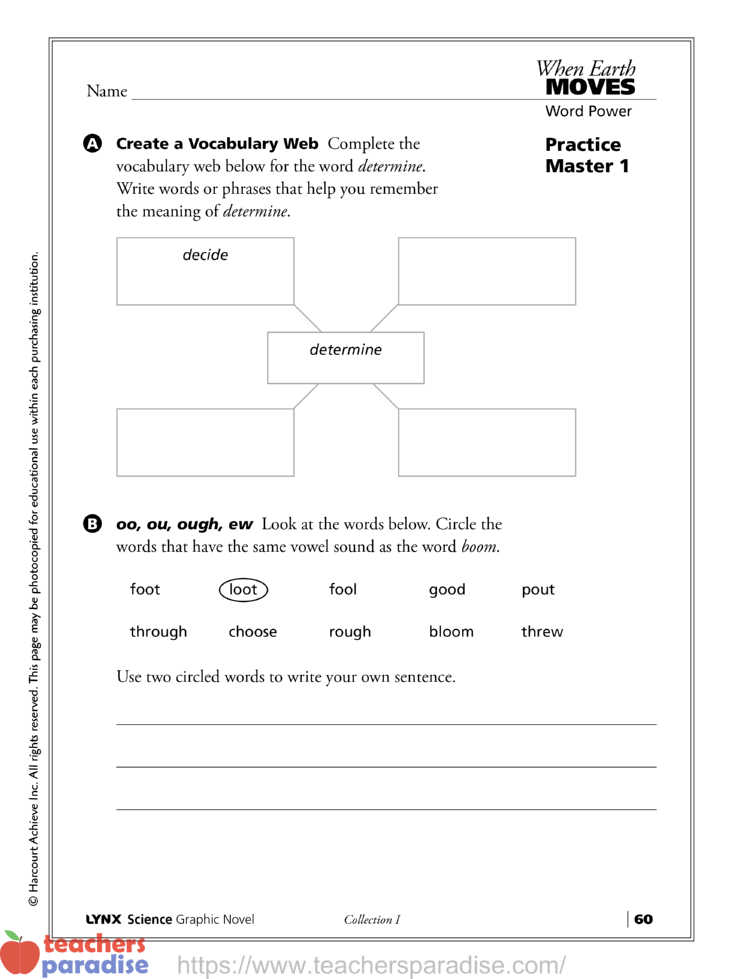
A. Create a Vocabulary Web
Complete the vocabulary web below for the word determine. Write words or phrases that help you remember the meaning of determine.
B. oo, ou, ough, ew
Look at the words below. Circle the words that have the same vowel sound as the word boom.
foot loot fool good pout
through choose rough bloom threw
Use two circled words to write your own sentence.
Practice Master 2
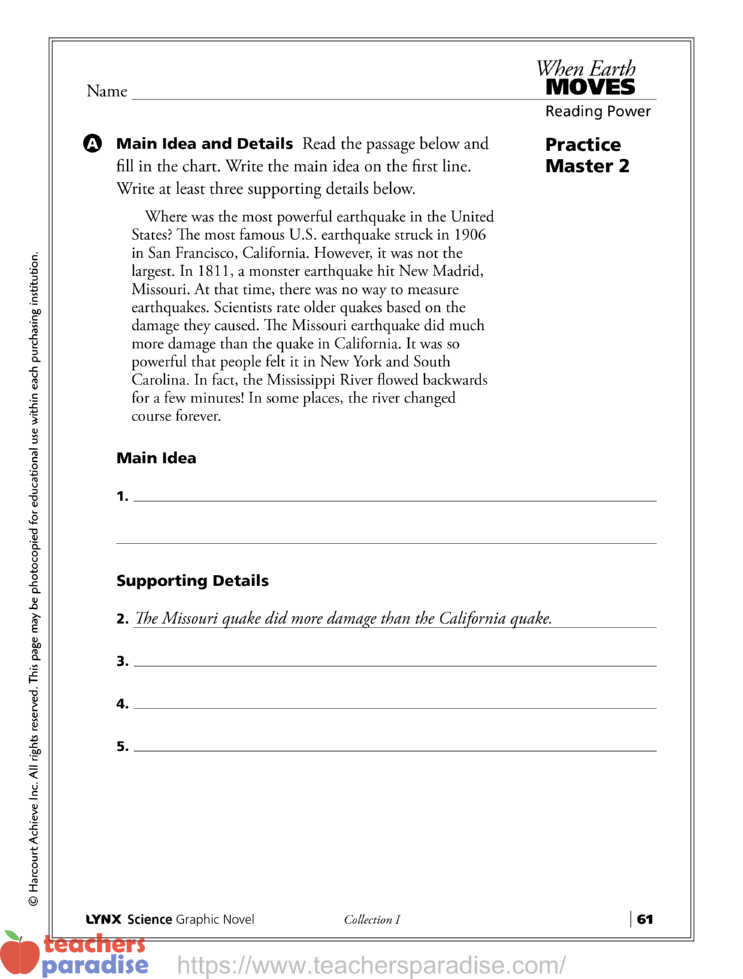
A. Main Idea and Details Read the passage below and fill in the chart. Write the main idea on the first line. Write at least three supporting details below.
Where was the most powerful earthquake in the United States? The most famous U.S. earthquake struck in 1906 in San Francisco, California. However, it was not the largest. In 1811, a monster earthquake hit New Madrid, Missouri. At that time, there was no way to measure earthquakes. Scientists rate older quakes based on the damage they caused. The Missouri earthquake did much more damage than the quake in California. It was so powerful that people felt it in New York and South Carolina. In fact, the Mississippi River flowed backwards for a few minutes! In some places, the river changed course forever.
When Earth Moves NONFICTION BOOK
STEP 1 Connect Theme Across Texts
Build Prior Knowledge from Reading
Review the Wrap Up on page 21 of Disaster Island with students. Help students make connections between the graphic novel and their textbook. Next, ask Which character most helped the teenagers get to safety? How did he or she help them understand the danger? What makes a volcano dangerous?
STEP 2 Build Word Power
Review Vocabulary Strategy: Synonyms and Antonyms
Introduce the new vocabulary words compression and vibration. Create a vocabulary web for compression. Use student input to fill in words or phrases with similar meanings (squeeze, pressure) and two with different meanings (loosen, open). Do the same with vibration. Invite students to use each word in a sentence.
Teach Word Study Strategy: Compound Words
Explain that a compound word is a single word made up of two smaller words. For example, underground is made up of under and ground. Compound words may be joined, hyphenated, or have a space between them.
• Point out earthquake on page 4. Ask a volunteer to say the two small words in this compound word. (earth, quake) Ask another student to define each of the smaller words, and then to define the compound word.
• Have students work in pairs to find definitions for the following compound words: overhead, sidewalk, aftershock, hilltop, notebook, undersea.
Support English Language Learners: Math Words
Read page 8 with students: “It left nearly 12,000 more injured.” Write twelve thousand on the board and say it aloud. Explain that twelve thousand is the number 12,000 in words. Write the following numbers and have volunteers write number words for each one: 2,500, 5,000, 8,600. Have students write a sentence using a number word in it.
STEP 3 Build Reading Power
Review Comprehension Strategy: Main Idea and Details
Remind students that a main idea is the most important thought in a paragraph or selection. Read the Introduction of Natural Disasters together. Ask students
What is the main idea?
Begin Reading Earthshaking Natural Disasters!
Have students read chapters 1 and 2 on their own. Remind them to use what they’ve learned so far as they read the selection.
Link to Student Research Topics
To learn more, students can investigate:
• Places around the world where earthquakes recently occurred or are likely to occur (e.g., California, Indonesia, Iran)
• Places around the world with active volcanoes, and how scientists are monitoring them (e.g., the Cascade Range in the U.S., Etna in Italy)
STEP 4 Support Understanding
Focus on Nonfiction Genre: Interview
Explain to students that in an interview, one person asks questions and another person answers. An interview is used to get information about a person. Reporters often use interviews. Ask Who from Earthshaking Natural Disasters! would you like to interview and why? What do you want to learn? What would you ask? Have students write the name of the person and three questions.
Focus on Text Feature: Cross-Sectional Diagrams
Ask students what the cross-sectional diagram on page 17 shows. Have a volunteer read step 1, and have other students indicate the part of the diagram that shows this step. Repeat for all three steps. Discuss why a diagram is a good way to convey information. Ask How does the diagram help you understand the steps? With what other topics would a diagram be helpful?
Accommodate for Learning Differences: Cross-Sectional
Diagrams Have students draw diagrams of waves nearing a shore. Make sure they show how the sea bottom gets more shallow near land and how the waves grow taller. Have them label their diagrams.
Finish Reading Earthshaking Natural Disasters!
Have students read the rest of the book. Remind them to keep in mind what they have learned as they read.
STEP 5 Wrap Up Theme
Discuss Earthshaking Natural Disasters!
Discuss the following:
• What causes an earthquake? What can cause a tsunami?
• Why does a tsunami build into a wall of water as it reaches a shoreline?
• What type of scientist is Seth Moran? Why is his job important?
Link to How Science Works
Scientists use evidence from past experiments and the theories of other scientists to determine how they will conduct their own research. In this way, scientific knowledge is tested and refined. Scientists are often the first people to react to natural disasters. The first priority in a disaster is to save lives. The second priority is to understand what happened in order to minimize harm from future natural disasters. Ask What other reasons are there for scientific research?
Analyze and Write Across Texts
Ask students to discuss the following: Did Mrs. Glassberg make the best decision by leaving California? Why? If Koshi Mackenroe John had the chance, would he move away? Why or why not? How would these people react to the events in Vacation on Disaster Island?
• Have students write a short essay about how people should react during a natural disaster and underline their main idea.
Link Theme to Textbook
Preview the headings, images, captions, and subtitles in: Earth Science Units on Earth’s surface, inside Earth, and Earth’s waters; Physical Science Units on sound and light; or Life Science Units on ecology and animals. Have students use these to make predictions. Students can confirm or revise predictions during reading.
Practice Master 3
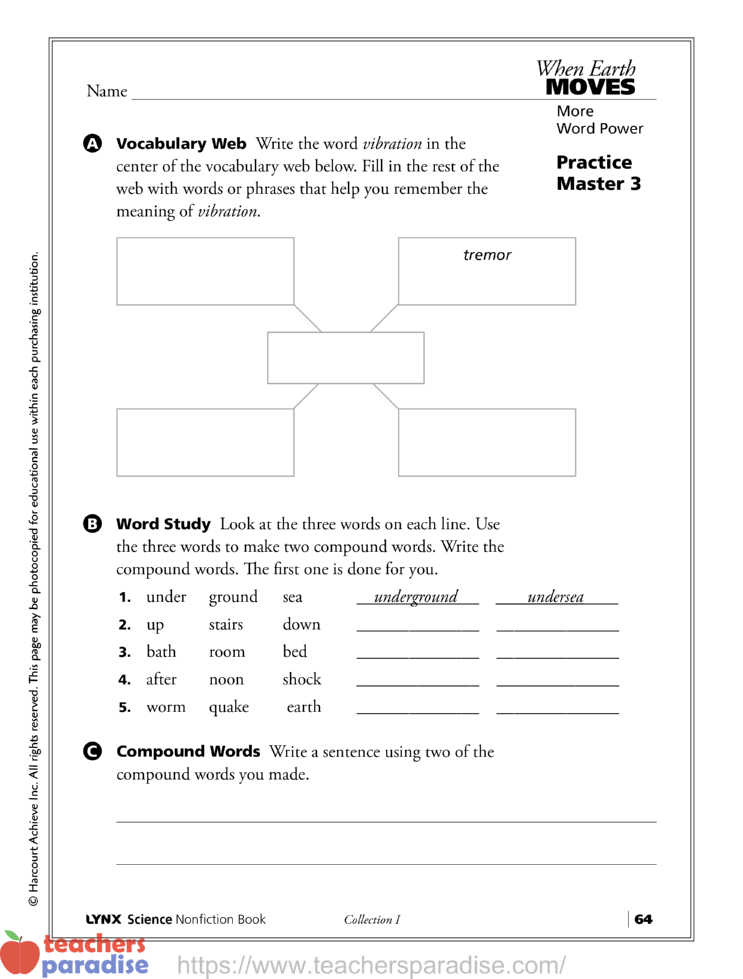
A. Vocabulary Web
Write the word vibration in the center of the vocabulary web below. Fill in the rest of the web with words or phrases that help you remember the meaning of vibration.
B. Word Study
Look at the three words on each line. Use the three words to make two compound words. Write the compound words. The first one is done for you.
C. Compound Words
Write a sentence using two of the compound words you made.
Practice Master 4
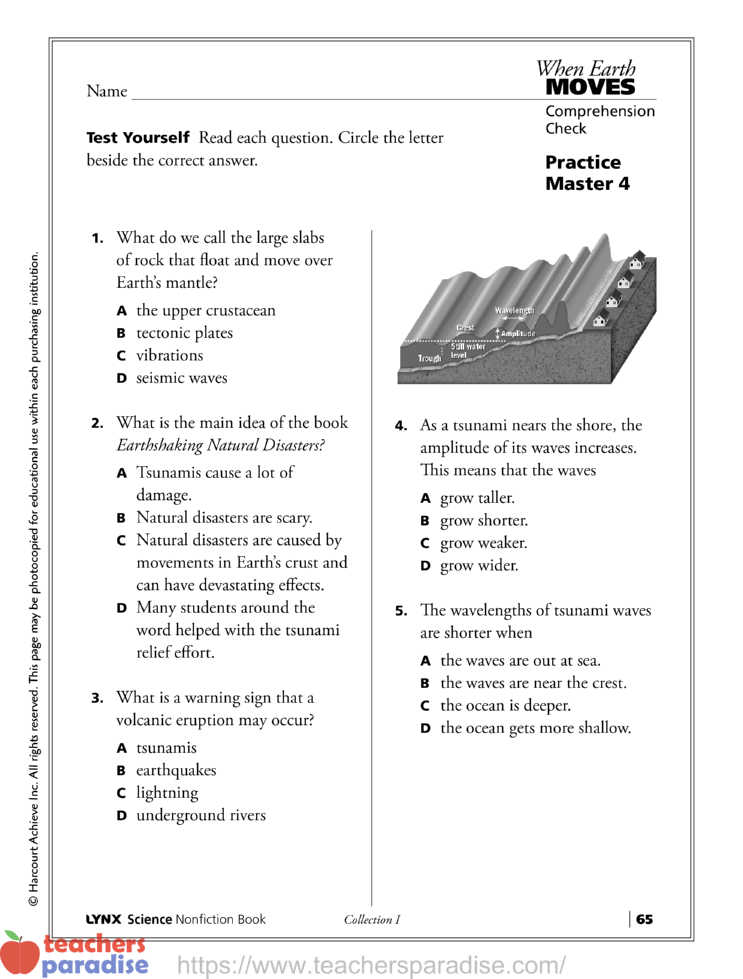
Test Yourself
Read each question. Circle the letter beside the correct answer.
- What do we call the large slabs of rock that float and move over Earth’s mantle?
A. the upper crustacean
B. tectonic plates
C. vibrations
D. seismic waves - What is the main idea of the book Earthshaking Natural Disasters?
A. Tsunamis cause a lot of damage.
B. Natural disasters are scary.
C. Natural disasters are caused by movements in Earth’s crust and can have devastating effects.
D. Many students around the word helped with the tsunami relief effort. - What is a warning sign that a volcanic eruption may occur?
A. tsunamis
B. earthquakes
C. lightning
D. underground rivers - As a tsunami nears the shore, the amplitude of its waves increases. This means that the waves
A. grow taller.
B. grow shorter.
C. grow weaker.
D. grow wider. - The wavelengths of tsunami waves are shorter when
A. the waves are out at sea.
B. the waves are near the crest.
C. the ocean is deeper.
D. the ocean gets more shallow.
Practice Master 5
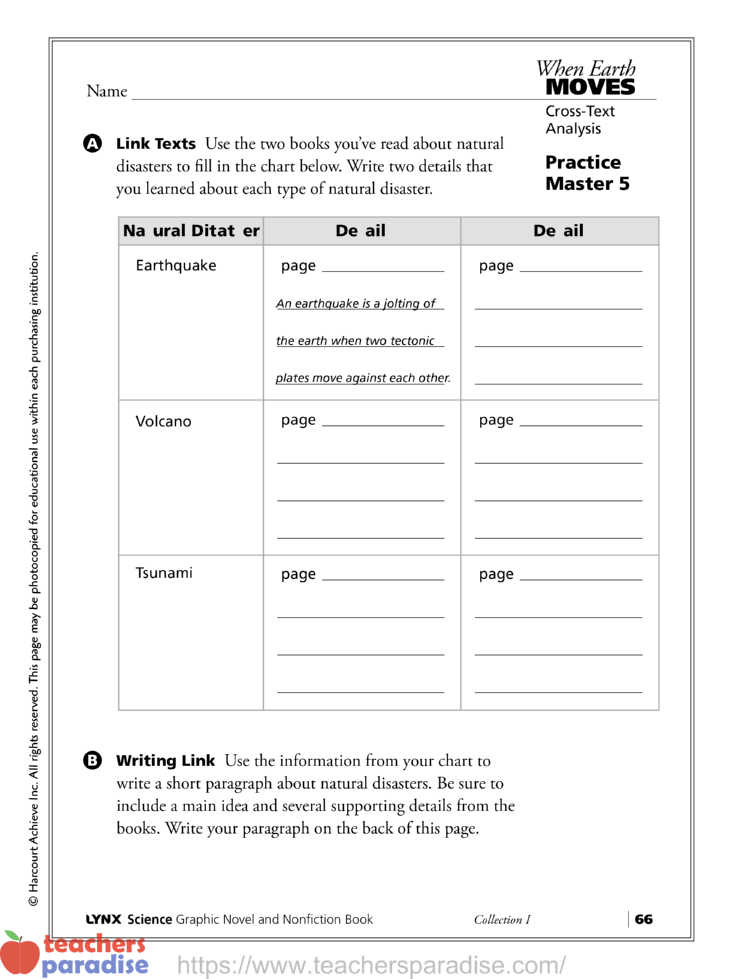
A. Link Texts
Use the two books you’ve read about natural disasters to fill in the chart below. Write two details that you learned about each type of natural disaster.
B. Writing Link
Use the information from your chart to write a short paragraph about natural disasters. Be sure to include a main idea and several supporting details from the books. Write your paragraph on the back of this page.
LYNX When Earth Moves – Answer Key
